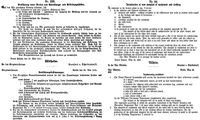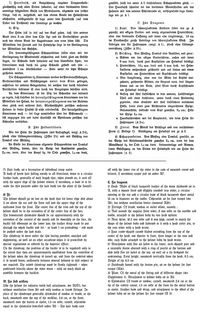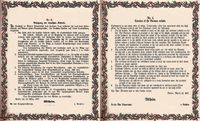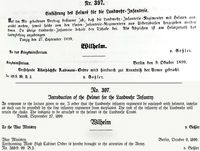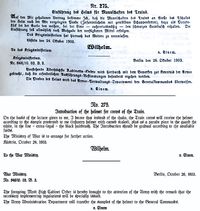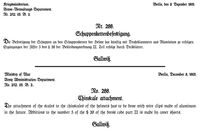25.05.1895:
Introduction of the M95 helmet for enlisted men of the infantry and officers in general.
- Further slightly height reduction in height of the helmet body and use of thinner core leather for its construction. The helmet height was about 21 cm to 21,3 cm (incl. 8-8,7 cm spike | Dragoons: 9,5 cm).
- In order to reduce the weight of the helmet, gold fittings were now made of aluminum bronze, while silver fittings were still made of nickel silver. The helmet weighed only about 360 to 575 g.
- For a better ventilation, the rear spine was provided with a vent in the upper area, which could be regulated by means of a slider.
- A new attachment concept for the 11-11,5 cm high eagle plate, which was made of tombac, was introduced. 2 wire loops soldered to the back of the plate were inserted through matching eyelets on the helmet, which made it possible to fix it with 2 leather pins. In this way, the eagle plate could be removed as quickly as possible in the event of mobilization and was still well secured.
- Reduction of the cockade diameter for enlisted men of foot troops to 48 mm. Mounted units retained a cockade diameter of 50 mm, since their helmets were not reduced in height.
- For officers of the infantry, field and foot artillery, engineer and pioneer corps, train and railroad troops, the helmet of the newer type was prescribed by the new clothing regulations for officers and medical officers of the Royal Prussian Army, Part II of 1895 (pages 26-30). However, dragoons, generals, non-regimental officers, land guards and the mounted military police were excluded for the time being and retained the old helmet model as far as possible until 1896.
27.06.1896:
Introduction of the M95 helmet for the rest of the enlisted men equipped with a pickelhaube. With the new clothing regulations for enlisted men part II, which was published on this day, the new helmet M95 was generally introduced. However, there were deviations for the field artillery and the dragoons:
- The helmet of the field artillery was similar to that of the foot troops, except for the ball. Since it was a mounted unit, instead of a chin strap, curved chinscales were worn on the helmet, which, like the fittings, were made of tombac or brass. In addition, the rear spine had no ventilation slider.
- The lower designed shell of the M95 helmet has now also been adopted for the Dragoons. However, the helmets were to be more robust because of the risk of injury while riding, which is why the thicker leather was retained here and the diameter of the reinforcing plate made of blackened sheet metal was to be 13 cm. The rear spine of the dragoon helmets didn’t have a ventilation slider, but it had a rotating spike to regulate the ventilation here. The other attributes like the cross fitting (or cloverleaf), the curved chinscale, the squared front visor and the rear visor with the only slightly rounded corners remained. Finally, the fittings and chinscales should be made of tombac or brass, just like for the field artillery.
22.03.1897:
Introduction of the imperial cockade for enlisted men and officers, which was always worn on the right side of the helmet. The state cockade moved to the left side of the helmet.
- Reduction of the cockade-diameter to 48 mm for all enlisted men (with the exception of metal helmets) - (Unfortunately, this is only an assumption, because I can only prove from the dress code that by 1903 at the latest, the cockade diameter for all units (with the exception of the metal helmets) was 48 mm. The change must therefore have taken place between 1896 and 1903).
- However, cockades of older designs were apparently still tolerated, because despite different regulations, cockades with a diameter of 50 mm were also found on authentic helmets up to 1915.
15.05.1899:
Minor changes to officers' pickelhaubes. With the new clothing regulations 2nd part of 1899 for officers, the helmet fittings are somewhat reduced in size:
- The spikes of officers' helmets are now to be only 9,5 cm high (B.O. 1895: 11,5 cm) under the new 1899 clothing Regulations.
- The ball fittings of the artillery officers’ helmets should now be only 7,0 cm (B.O. 1895: 10,5 cm) high according to the new 1899 clothing regulations.
- The helmet eagle of the Guard officers were to be 12,7 cm high (B.O. 1895: 11,0 cm) and 28,0 cm wide (B.O. 1895: 23,0 cm) in the future according to the new clothing regulations of 1899.
27.09.1899:
Introduction of the M95 helmet for enlisted men of „Landwehr“ infantry.
- The introduction took place gradually from surpluses. The remaining „Landwehr“ infantrymen retained the shako for the time being.
24.10.1903:
Introduction of the M95 helmet for enlisted men of the Train.
- The Pickelhaube gradually replaced the shako, that has been previously worn by the enlisted men of the Train.
08.12.1905:
The wire staples used to attach the scales to the chinscales were to be made of aluminum in the future.
27.09.1909:
Introduction of the red maneuver ribbons on the helmet covers, to distinguish the parties during maneuver exercises.
